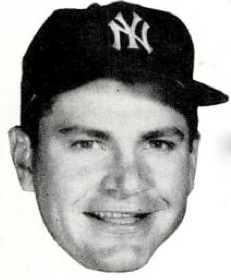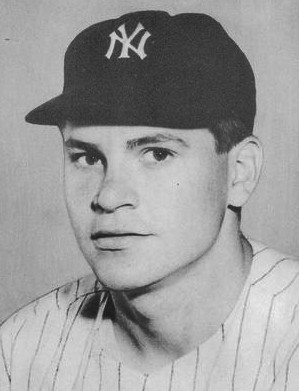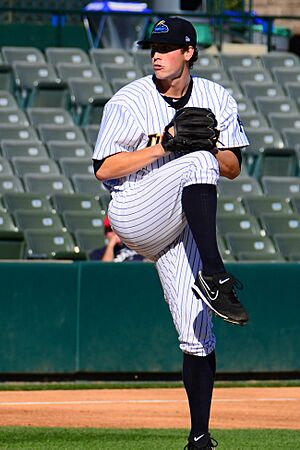Bob Turley facts for kids
Quick facts for kids Bob Turley |
|||
|---|---|---|---|

Turley in 1959
|
|||
| Pitcher | |||
| Born: September 19, 1930 Troy, Illinois, U.S. |
|||
| Died: March 30, 2013 (aged 82) Atlanta, Georgia, U.S. |
|||
|
|||
| debut | |||
| September 29, 1951, for the St. Louis Browns | |||
| Last appearance | |||
| September 21, 1963, for the Boston Red Sox | |||
| MLB statistics | |||
| Win–loss record | 101–85 | ||
| Earned run average | 3.64 | ||
| Strikeouts | 1,265 | ||
| Teams | |||
|
|||
| Career highlights and awards | |||
|
|||
Robert Lee Turley (1930–2013) was a famous American professional baseball player. People knew him as "Bullet Bob" because of his super-fast pitches. He played as a pitcher in Major League Baseball (MLB) from 1951 to 1963. After baseball, he worked in financial planning.
Turley started his MLB career with the St. Louis Browns in 1951. He later moved with the team to Baltimore, where they became the Baltimore Orioles. He played in his first MLB All-Star Game in 1954. After that season, he joined the New York Yankees. With the Yankees, Turley became a two-time World Series champion. He won the Cy Young Award and the World Series Most Valuable Player Award in 1958. He finished his career with the Los Angeles Angels and Boston Red Sox in 1963.
Contents
Bob Turley's Early Life
Turley was born in Troy, Illinois, and grew up in East St. Louis, Illinois. He played baseball for his high school team for three years. By his senior year in 1948, he was the team's best pitcher. He even won a sportsmanship award that year!
Right after high school, Turley signed with the St. Louis Browns. He got a $600 bonus for joining the team.
Playing Professional Baseball
Minor Leagues and Early MLB Days
Turley started his professional career in the Minor League Baseball in 1948. He quickly showed off his skills. In 1949, he led his league with 23 wins and 205 strikeouts. He was even named the most valuable player in the Texas League in 1951. In one game, he struck out an amazing 22 batters!
Turley played his first MLB game on September 29, 1951. After that, he joined the United States Army for two years. He returned to the Browns in 1953. In 1954, the team moved to Baltimore and became the Baltimore Orioles. Turley was known as a "power pitcher" because he threw very hard. He led the American League in strikeouts with 185 that year. But he also led the league in walks (181) because his control wasn't perfect.
It was during his time with the Orioles that he got the nickname "Bullet Bob." A magazine measured his fastball speed. It was recorded at 98 miles per hour when it reached home plate!
Joining the New York Yankees
The New York Yankees wanted Turley because they needed strong young pitchers. After the 1954 season, the Orioles traded Turley to the Yankees. This trade was huge! It involved 17 players, making it the largest trade in MLB history.
Turley played for the Yankees from 1955 to 1962.
- 1955 Season: He won 17 games and had 210 strikeouts. The Yankees won the American League title. They played in the 1955 World Series but lost to the Brooklyn Dodgers.
- 1956 Season: Turley had a tough year, but the Yankees still won the American League. They faced the Dodgers again in the 1956 World Series. This time, the Yankees won the series!
- 1957 Season: Turley improved his pitching by adding a curveball. His earned run average (ERA) was one of the best in the league. The Yankees won the league title again. But they lost the 1957 World Series to the Milwaukee Braves.
Turley's Amazing 1958 Season
The 1958 season was Turley's best ever! He won 21 games and lost only seven. This was the best winning percentage in the American League. He also completed 19 games, meaning he pitched the entire game himself.
In the 1958 World Series, the Yankees faced the Milwaukee Braves again. Turley had a rough start in Game Two. But he bounced back in a big way!
- In Game Five, with the Yankees close to losing the series, Turley pitched a complete game shutout. This means he pitched the whole game and didn't let the other team score any runs.
- In Game Six, he came in as a relief pitcher and earned a save in the 10th inning.
- In Game Seven, he came in again as a relief pitcher and helped the Yankees win the game and the World Series!
The Yankees became only the second team to win the World Series after being down 3-1. Turley was named the World Series Most Valuable Player. For his amazing year, he also won the Cy Young Award as the best pitcher in all of Major League Baseball. He was also named The Sporting News Player of the Year.
Later Years and Coaching
Turley's fastball started to lose some speed after 1958. He had elbow problems in 1961 and 1962. He had surgery to fix bone chips in his elbow. He pitched less and was used more as a relief pitcher. The Yankees won the 1961 World Series and 1962 World Series, but Turley didn't play much in those series.
After the 1962 season, the Yankees traded Turley to the Los Angeles Angels. He struggled there and was released in July 1963. He then signed with the Boston Red Sox and retired after the 1963 season. He finished his career with 101 wins and 85 losses.
After retiring as a player, Turley became the pitching coach for the Red Sox in 1964. He tried to make a comeback as a pitcher in 1965 but didn't make the team.
Sign Stealing Skills
While on the bench, Turley had a special skill: he could "steal" signs from the other team's pitcher. This meant he figured out what pitch was coming next. He would then whistle to let his teammates know. Some players, like Johnny Blanchard and Elston Howard, liked the help. Others, like Yogi Berra, didn't care.
Once, a pitcher named Jim Bunning noticed Turley's system. He warned Turley to stop. But Turley whistled anyway, and Bunning threw a very fast pitch that Mickey Mantle missed. Mantle and Roger Maris both credited Turley's sign-stealing with helping them hit more home runs.
Turley's Life After Baseball
Turley started working as a financial planner in 1957, even while playing baseball. He sold life insurance. In 1977, he helped start an insurance company that later became Primerica. He retired from that business in 2001.
Turley also loved real estate. He bought and sold many houses in Florida. He even built a huge house that people called "Turley Mansion."
Turley's uncle, Ralph, also played professional baseball. Interestingly, the Yankees once signed Ralph by mistake, thinking he was Bob! Nik Turley, another baseball player, is a distant relative of Bob Turley.
Bob Turley passed away on March 30, 2013, at the age of 82.
See also
- List of Major League Baseball annual strikeout leaders
- List of Major League Baseball annual wins leaders



